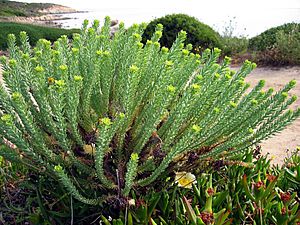Sea Spurge facts for kids
Quick facts for kids Sea Spurge |
|
|---|---|
 |
|
| Sea Spurge in La Revellata, Corsica | |
| Scientific classification | |
| Genus: |
Euphorbia
|
| Species: |
paralias
|
Euphorbia paralias, also known as the sea spurge, is a type of flowering plant. It belongs to the Euphorbiaceae family. This plant is originally from parts of Europe, northern Africa, and western Asia.
The sea spurge has spread widely in Australia. There, it is considered an invasive species. It takes over sandy coastal areas. This can push out local plants and affect places where certain birds like to nest. Large projects have been started to remove it. For example, the Sea Spurge Remote Area Teams in Tasmania have had great success.
What Sea Spurge Looks Like
Sea spurge is a plant that grows upright. It can reach up to 70 centimeters (about 27 inches) tall. It has a slightly blue-green color, which is called glaucous. This plant is a perennial plant, meaning it lives for more than two years.
The plant has many stems. These stems divide into 3 to 5 main branches that produce flowers. Each of these branches then divides even more.
Leaves and Stems
The leaves that grow directly from the main stem are called cauline leaves. They are packed closely together and overlap. These leaves are thick and fleshy. They are shaped like an oval, wider at the top, and are about 5 to 20 millimeters (0.2 to 0.8 inches) long.
The leaves on the branches that produce flowers are more rounded. They can be shaped like a circle with flat sides or like a kidney.
Flowers and Seeds
The flowers of the sea spurge are found in a special cup-shaped structure called a cyathia. This structure is usually found where branches fork or at the very top of the plant. It is surrounded by bell-shaped leaves called bracts.
Female flowers have styles that split into two short parts called stigmas. Sea spurge flowers from September to May.
The fruit of the plant is a capsule. It can be flattened from the top or almost round. It has deep grooves and looks wrinkled along its edges. The seeds inside are oval-shaped, pale gray, and smooth. Each seed has a kidney-shaped, fleshy part growing from its outer layer.
See also
 In Spanish: Euphorbia paralias para niños
In Spanish: Euphorbia paralias para niños

